|
|
|
|
Overview
|
| About | ||
|
|
||
The pages below describe, in simple terms, the structure of flowers, inflorescences and fruits and seeds. Some important terms and concepts used to describe these in Families of Flowering Plants of Australia may be unfamiliar to users of the key - use these notes as an introduction; as you use the key, reading the notes associated with individual character states will help also.
A flower is the structure by which flowering plants reproduce sexually. The appearance of flowers was one of the most important advances in the development of land plants, and evolution of the flower in different families has produced a myriad of forms, shapes and colours. Although there is great variety in the structure and appearance of flowers, all flowers are based upon a relatively simple common pattern.
A flower comprises two basic types of structures: those directly involved in reproduction and those only indirectly involved. The structures that are directly involved are the stamens (which hold the male sexual spores or pollen) and carpels or ovary (which hold the female sexual spores or ovules). These are always found in the very centre of the flower. Around them may be petals, sepals, nectaries etc. While not directly involved in reproduction, these also have important functions in the flower, including protecting the inner parts or attracting or guiding pollinators to them.
It is customary when describing flowers to begin with the outer structures and work in towards the centre of the flower.
The perianth
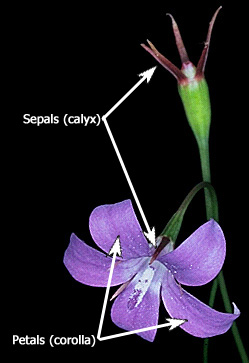 In most flowers a ring or whorl
of green sepals can be easily seen around the outside of the
flower, that cover and protect the flower bud, and a ring or whorl of
larger, white or coloured petals that attract pollinating
animals. Collectively, sepals and petals are parts of the perianth.
In most flowers a ring or whorl
of green sepals can be easily seen around the outside of the
flower, that cover and protect the flower bud, and a ring or whorl of
larger, white or coloured petals that attract pollinating
animals. Collectively, sepals and petals are parts of the perianth.
Not all flowers have clearly distinct sepals and petals. In some flowers the petals may be absent so that there is only one whorl of parts (the sepals), while in others, particularly in monocotyledonous families such as lilies, there are two whorls of perianth parts that are similar in shape and colour rather than strongly differing like sepals and petals. In still other flowers, particularly in small ones that are pollinated by wind or water and don't need to attract pollinators, the perianth may be completely absent, the flower in these cases consisting of a naked ovary and/or stamens.
If sepals are present, the whorl of sepals is collectively called a calyx. If petals are present, the whorl of petals is collectively called a corolla. If a perianth is present but the parts are not differentiated into sepals and petals, the parts are simply called perianth-parts in this key.
In Families of Flowering Plants of Australia there is an important character at the beginning of the floral characters, that asks "what type of perianth do you have":
 |
This is an important character because it is a major "branch" in the key:
If you have a flower with a distinct calyx whorl of sepals and a distinct corolla whorl of petals, then answer with the first state. A large block of characters (those that are applicable to flowers with a perianth that is not differentiated into sepals and petals) will disappear from the key.
If you have a flower with only one whorl of perianth parts (whether the parts look like sepals or petals) or with two or more whorls that are similar to each other, then answer with the second state. Two large blocks of characters (those that deal specifically with sepals and petals) will disappear from the key.
If you have a flower without a perianth or with a perianth reduced to tiny lobes or scales, then answer with the third state. All characters that deal with the perianth will disappear, since these characters will be inapplicable to your flower.
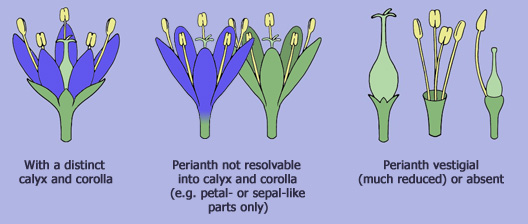
For any given whorl (sepals, petals or perianth parts) the individual parts may be free from each other or they may be fused into cups, bell shapes or tubes. For instance, many flowers have a short or long corolla tube, while many others have the sepals fused into a short cup. Several characters in the key refer to the degree of fusion and shape of these parts. Look at the illustrations accompanying the characters to learn about the different shapes and their names.
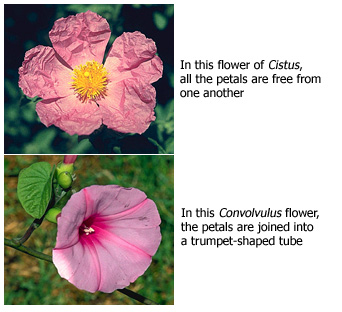
An important feature to note when looking at a flower is the symmetry of the perianth when viewed from above. In most flowers the petals and sepals or perianth parts are arranged more or less evenly around the centre of the flower so that the flower can be divided into equal halves in two or more ways. Such flowers are called regular or actinomorphic. In some flowers, however, the parts are arranged so that there is only one line of symmetry, and the flowers are bilaterally symmetric. Such flowers are called zygomorphic. The characters Perianth symmetry, Calyx symmetry and Corolla symmetry refer to this feature, and the diagrams attached to these characters should make the difference clear.
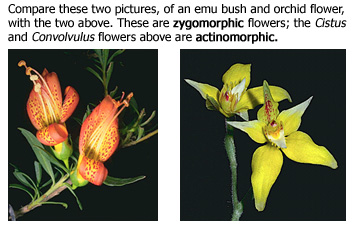
The stamens or androecium
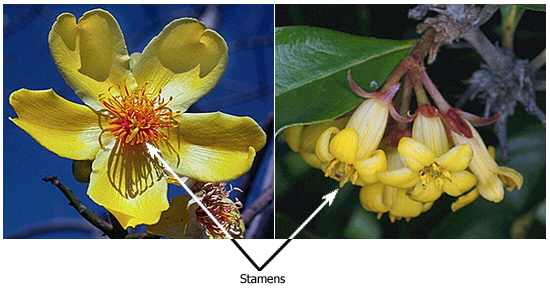
The number and arrangement of stamens is important. Stamens are often borne in very definite positions in the flower, and you should look closely to determine this. Probably the most common condition has the stamens equal in number to the petals and borne regularly so that one stamen arises between each pair of adjacent petals. In some flowers in which the petals and stamens are equal in number, by contrast, the stamens arise adjacent to each petal, so that a line drawn from the centre of a petal's insertion to the centre of the flower will pass through a stamen. Carefully opening the flower and finding where the stamens are inserted will show this. Other common patterns are seen in flowers with regularly twice as many stamens as petals, in which half the stamens are adjacent to a petal and half are inserted between the petals, and flowers with many stamens and no particular relationship between individual stamens and the petals or sepals.
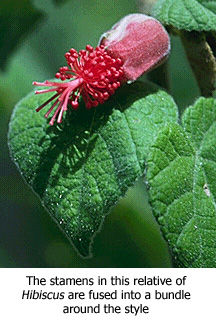 Stamens are usually all free from
each other and arise individually at the base of the petals or perianth
parts around the ovary. In some flowers, however, the stamens are
united with each other or with the perianth parts, or sometimes even
with the ovary or style. Sometimes, for instance, the stamens arise
from the surface of a petal or from the inner surface of the tube of a
tubular corolla. In other flowers, individual stamens may be grouped
together into bundles or fused into a tube surrounding the ovary in the
centre of the flower. Careful observation, perhaps with a hand lens,
may be necessary to work out these arrangements.
Stamens are usually all free from
each other and arise individually at the base of the petals or perianth
parts around the ovary. In some flowers, however, the stamens are
united with each other or with the perianth parts, or sometimes even
with the ovary or style. Sometimes, for instance, the stamens arise
from the surface of a petal or from the inner surface of the tube of a
tubular corolla. In other flowers, individual stamens may be grouped
together into bundles or fused into a tube surrounding the ovary in the
centre of the flower. Careful observation, perhaps with a hand lens,
may be necessary to work out these arrangements.
The carpels, ovary or gynoecium
The centre of most flowers is the female part. The basic unit of this is a hollow sac called a carpel which bears, attached inside it, one or more egg-sacs or ovules. Carpels are usually green or greenish and often somewhat fleshy. At its tip, or somewhere on its outer surface, a carpel usually has a patch of special tissue called a stigma that receives the male pollen. Pollen falling or deposited onto the stigma germinates, producing a microscopic pollen tube that grows into the carpel and fertilises an egg cell, which subsequently grows into a seed. The stigma is often raised high above the ovary on a slender style.
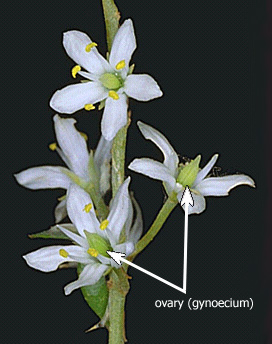
The arrangements of carpels at the centre of the flower are many and varied. In some, relatively few, flowers, there is a single carpel, or several carpels that are free from each other and individually discernable. More usually, however, several carpels are fused together into a single, compound, structure called an ovary. An important feature for separating many families is how many carpels are present in a flower. This may be difficult to tell if the carpels are fused together. There are several ways of telling. Sometimes, it is clear from the outside of the ovary that it comprises several carpels, as alternate bulges and grooves mark the divisions. More usually, it will be necessary to carefully cut the ovary in half transversely, about half way between its base and the base of the style. In the cut section, you should be able to see one or more chambers (called loculi). If there are several chambers, the number of carpels is almost always equal to the number of chambers. If, however, there is only one chamber, the issue is a little more difficult. Look at the style, and count the number of branches or individual stigmas at its tip. The number of carpels is usually equal to the number of branches or stigmas. A better way is to carefully look at the way the tiny ovules are attached inside the locules. Ovules are usually attached to the wall of the ovary on a small pad of tissue called a placenta. You may be able to count the number of placentas inside the loculus: the number of carpels is equal to the number of placentas (even if this differs from the number of style branches). The diagrams attached to the character Number of carpels should make this clearer.

Another important feature of the ovary is its position vertically in the flower. Carefully pull off a petal or perianth part (or remove the corolla or perianth tube if the parts are not free). If the parts are attached at the base of the ovary, the ovary is said to be superior. If they are attached at the summit of the ovary, it is inferior. Sometimes flowers have an intermediate arrangement, when the ovary is said to be half-inferior. Another way of determining this is to look at the flower from above and below. If the ovary is superior it will be visible from above but not below, if inferior it will be visible from below but not above, if half-inferior part of the ovary will be visible above and part below. Be careful though to check that the part you think is the ovary really does bear ovules inside its hollow chambers – sometimes flower parts other than the ovary (such as the base of the style or the tip of the flower-stalk) may be swollen and look like part of the ovary.
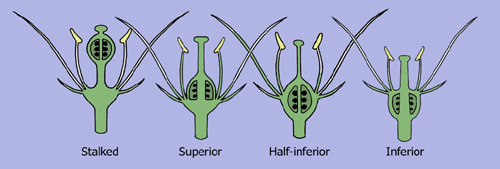
The structure of inflorescences
 An inflorescence is a
flowering shoot, comprising one or more flowers borne on the plant in a
definite arrangement. Inflorescences may be very complex structures.
They almost always have very definite branching patterns and shapes,
and occur in particular positions on the plant.
An inflorescence is a
flowering shoot, comprising one or more flowers borne on the plant in a
definite arrangement. Inflorescences may be very complex structures.
They almost always have very definite branching patterns and shapes,
and occur in particular positions on the plant.
What is an inflorescence?
All plants bear their flowers in particular arrangements and in particular places within the shoot system of the plant. For instance, some plants may always have single flowers arising from the axils of leaves towards the tips of branches, some may have long spikes of flowers arising from the end of a growing shoot, while some trees may bear branching clusters of flowers from old wood or even from the trunk. These arrangements and positions are described under the characters concerning inflorescences.
The main types of inflorescences
The most simple inflorescence is a single, solitary flower. Most plants, however, bear groups of flowers, probably because a group of flowers is more visible and hence more attractive to pollinators. If flowers are borne in a group, there is usually a branching shoot on which the flowers are carried. The patterns of branching of this shoot provides the main way of classifying inflorescences into types.
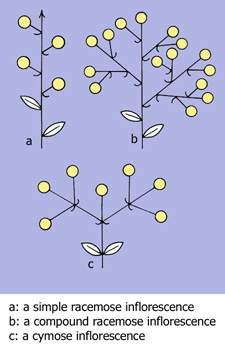 |
There are two main branching patterns. A racemose pattern has branches produced along an elongate axis, usually alternately. These side-branches may themselves be branched, and the tip of the inflorescence may bear a flower, a vegetative bud or an aborted bud. In a cymose pattern, the inflorescence axis first produces a single flower bud, then one (or more usually two) side axes develop below the bud each of which terminates in another bud, and the whole process is repeated.
The branching patterns described above are simplified, idealised ones. Many inflorescences appear more complicated than these types, usually because the branching pattern is not discernable because some axes are contracted and stay very short (producing whorls of branches or clusters of flowers) or because the two basic branching patterns are mixed in the inflorescence.
 |
Spikes – an unbranched racemose inflorescence in which the individual flowers lack stalks |
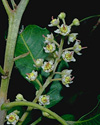 |
Racemes – an unbranched racemose inflorescence with stalked flowers |
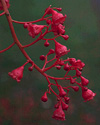 |
Panicles – a branching racemose inflorescence |
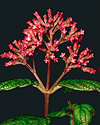 |
Cymes – an inflorescence that comprises a repeating pattern of cymose units |
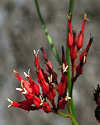 |
Corymbs – a flat-topped panicle in which all the flowers are borne at the same level |
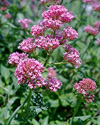 |
Thyrses – a mixed inflorescence with a racemose main axis bearing cymose side axes |
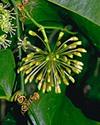 |
Umbels – a flat-topped inflorescence in which all the branches arise at the same point |
 |
Spikelets – a specialised inflorescence found in many grasses and sedges, with small flowers enclosed by large bracts, with these units arranged racemosely |
 |
Heads – an inflorescence (whether racemose or cymose) in which all axes remain so short that the flowers are borne in a tight cluster |
 |
Small Clusters – an inflorescence with some, but not all, axes contracted so that there are several small, dense clusters of flowers making up the inflorescence |
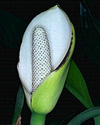 |
Fleshy Spikes – an inflorescence with small, stalkless flowers more or less embedded in a fleshy spike |
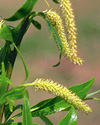 |
Catkins – an inflorescence with small flowers in a drooping spike or raceme, each flower more or less hidden by large bracts |
 |
Figs – a specialised inflorescence in which the flowers are borne inside a fleshy receptacle |
It will be clear from this list that many separate features – branching patterns, flower stalks, degree of elongation or contraction of branches, presence of enveloping floral bracts – together define these inflorescence types. Despite this, the types are usually straightforward and readily recognisable. In fact, they are usually more easily recognised than they are analysed and described rigorously, which is why we have chosen to treat inflorescences like this. Use the illustrations attached to the Inflorescence type character to get to know the types.
However, because of the great complexity and many variations possible in inflorescences, you may sometimes come across types that cannot be readily classified in this scheme. In such cases, either skip the character or choose several states to cover all possibilities.
Inflorescence bracts
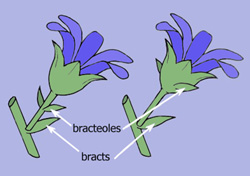 Many inflorescences
have small or large bracts at the points where one branch
diverges from another or at the bases of the flowers. Bracts are small
or large scales or flaps of tissue that may be green and leaf-like or
dry and papery in texture. Sometimes the whole inflorescence is
surrounded when young by a large bract (called a spathe). One
character in Families of Flowering Plants of Australia asks
whether bracts are present in the inflorescence – this is sometimes
difficult to see immediately because some inflorescences have bracts
subtending their branches when very young, but that fall off as the
inflorescence expands. Always look at young inflorescences or at the
tips where the flowers are still in early bud, if there seem to be no
bracts.
Many inflorescences
have small or large bracts at the points where one branch
diverges from another or at the bases of the flowers. Bracts are small
or large scales or flaps of tissue that may be green and leaf-like or
dry and papery in texture. Sometimes the whole inflorescence is
surrounded when young by a large bract (called a spathe). One
character in Families of Flowering Plants of Australia asks
whether bracts are present in the inflorescence – this is sometimes
difficult to see immediately because some inflorescences have bracts
subtending their branches when very young, but that fall off as the
inflorescence expands. Always look at young inflorescences or at the
tips where the flowers are still in early bud, if there seem to be no
bracts.
A special type of bract is a bracteole. This is a small bract found on the stalk or at the base of the calyx of each flower. Bracteoles may be empty (that is, with no flower bud inside them) or they may subtend another flower bud. It is sometimes difficult to tell a floral bracteole from an inflorescence bract (this is difficult because there is no real difference, except in position).
How to determine what is the inflorescence unit
Some inflorescences are clearly distinct from the leafy shoot that bears them. There may be well-developed leaves on the shoot, then a sudden change to a flower-bearing part, perhaps with a distinctly different pattern of branching or with distinctly un-leaflike bracts or without bracts at all. In such cases, the inflorescence characters refer to the parts of the shoots that bear flowers and are distinctly different.
In other cases, however, there is a gradual transition from normal leaves through reduced leaves to leaf-like bracts, and the branching pattern of the inflorescence may be similar to the branching pattern of a normal, vegetative shoot. In such cases, it may be difficult to tell just what is the inflorescence, and characters such as Inflorescence position maybe difficult to answer.
 A seed is the small package by which a plant
disperses new individuals formed from the fertilization of an ovule. A
fruit is the structure that holds the seeds before, and sometimes
after, they are shed from the plant. The evolution of seeds was one of
the most important advances in the development of land plants,
predating the evolution of flowers (conifers, cycads and some other
groups of plants have seeds, but no flowers).
A seed is the small package by which a plant
disperses new individuals formed from the fertilization of an ovule. A
fruit is the structure that holds the seeds before, and sometimes
after, they are shed from the plant. The evolution of seeds was one of
the most important advances in the development of land plants,
predating the evolution of flowers (conifers, cycads and some other
groups of plants have seeds, but no flowers).
Development of seeds and fruits
Inside the ovary of a flower are one or more (sometimes many) ovules. These are small, usually rounded structures that have inside them an egg cell. When the sperm cell from a pollen tube penetrates the egg cell and fertilises it, the ovule normally develops into a seed. The fertilised egg cell divides many times to become an embryo, the outer cell layer or layers of the ovule usually harden to become the seed coat to protect the embryo once it is shed, while other cells in the ovule may develop into feeding tissue for the developing embryo or into storage tissue to hold food for the germinating seed. The seed, then, is a package for an embryo.
 A fruit is the mature
ovary, that has usually grown larger as the ovules have developed into
seeds. Each fruit may contain from one to many thousands of seeds. The
fruit may be enveloped in remnants of the petals or sepals, or these
may have fallen away to leave the fruit naked on the flower stalk.
A fruit is the mature
ovary, that has usually grown larger as the ovules have developed into
seeds. Each fruit may contain from one to many thousands of seeds. The
fruit may be enveloped in remnants of the petals or sepals, or these
may have fallen away to leave the fruit naked on the flower stalk.
Once the seeds have matured inside the fruit, one of several things may happen. The fruit may split open to release the seeds, it may remain unsplit and fall from the plant with the seeds inside, or it may split into fragments each of which contains one or more seeds, and these fragments then fall from the plant and disperse.
It's not always straightforward to tell which of these has happened, without careful observation, and the words "seed" and "fruit" as commonly used are not always botanically accurate. For instance, a poppy seed is a true seed, but a sunflower "seed" is actually a fruit (that is, a matured ovary with a seed inside), while a carrot "seed" is actually a half-fragment of a fruit with a seed enclosed. For this reason, Families of Flowering Plants of Australia uses the word disseminule instead of seed or fruit in many instances. The disseminule is the structure that actually disperses from the plant, carrying one or more embryos with it. A seed, a whole fruit, or a fruit fragment may be the disseminule in different plants.
How to tell the type of disseminule
One character, Basic unit of dissemination, asks which of these three types of dispersal structure you have. To answer this, carefully observe some fruits as they are shedding from the plant:
If, at maturity, the fruit does not split in any way and falls intact, then the disseminule is the whole fruit. Berries and apples are examples of fruit disseminules. Fruit disseminules are often fleshy and coloured to attract fruit-eating birds, although this is not always the case.
If, at maturity, the fruit splits open to reveal its interior chamber or chambers from which individual seeds fall and disperse, then the disseminule is a true seed. Fruits that shed true seeds are often dry-textured and dull-coloured. Most wattles, for example, have splitting fruits and true seeds as disseminules.
If, at maturity, the fruit splits into two or more fragments without splitting open to reveal the seed-chambers, and after these have fallen no part (or only a small part) of the fruit remains attached, then the disseminule is a fruit fragment or schizocarp. Members of the family Apiaceae, some members of the Mallow family (Malvaceae) and maples (family Aceraceae) are good examples.
Compound fruits
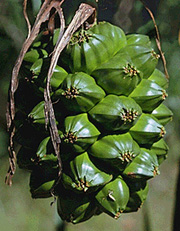 A fruit was defined above as the
mature ovary once the seeds are ripe. In some plants, however, ovaries
of several flowers fuse together to form a compound fruit. Pineapples
(family Bromeliaceae), pandans (family Pandanaceae) and the east-coast
Turpentine (Syncarpia glomulifera, family Myrtaceae) are
examples. Compound fruits may be shed whole for dispersal, or each
fruit may split to release its seeds. The character Derivation of
Fruit addresses this characteristic.
A fruit was defined above as the
mature ovary once the seeds are ripe. In some plants, however, ovaries
of several flowers fuse together to form a compound fruit. Pineapples
(family Bromeliaceae), pandans (family Pandanaceae) and the east-coast
Turpentine (Syncarpia glomulifera, family Myrtaceae) are
examples. Compound fruits may be shed whole for dispersal, or each
fruit may split to release its seeds. The character Derivation of
Fruit addresses this characteristic.
Dry and fleshy fruits
The most important distinction in fruits that do not split open at maturity to release the seeds (i.e. indehiscent fruits) is whether the texture of the fruit is dry or fleshy. Most indehiscent fruits are clearly either one or the other, and the character Fruit texture (indehiscent fruits only) can be answered easily. There is a grade in texture, however, and some fruits will be intermediate – somewhat dry-fleshed. In cases like this it would be best to skip this character.
Fleshy fruits may contain a single seed, or several seeds (or "stones" – seed-like structures that develop from a bony carpel wall and enclose a true seed). If there are relatively few seeds or stones and the fruits are relatively large, you can usually easily count them by pressing the fruit between thumb and forefinger to "squirt out" the seeds, then answer the character Number of seeds (or stones) per fruit. This character applies to dehiscent fruits also.
 Capsular fruits
Capsular fruits
Probably the most common type of dehiscent fruit (i.e. one that splits to release the seeds) is the capsule. Many families have members with capsular fruits. You should look carefully at the way capsules split, and answer if you can the character Capsule dehiscence. Some capsules split around their equator, or around the apex so that they open by a lid. Others open several pores near their apex, or have short apical slits. The most common type of splitting, however, is by long, longitudinal splits from apex to base. In this case, though, there are still several possibilities, depending on whether the splits occur along the midlines of the carpels or on the lines where the carpels join.
Ornamentation on the disseminule
Disseminules are often adapted for specific types of dispersal, such as by animals, wind or water. Particular structures are often involved in this, such as wings or fine, cottony hairs (for wind dispersal) or hooks, sharp spines or sticky surfaces (for animal dispersal). The character Large-scale features of the disseminule lists a number of such features. Of course, many disseminules will be relatively featureless in this respect.
Seed disseminules often have a finely ornamented seed coat, visible under a handlens (or low-power microscope if the seed is very small). Ornamentation like this is often very characteristic of particular species. The character Fine-scale ornamentation of the disseminule lists a number of types of ornamentation.